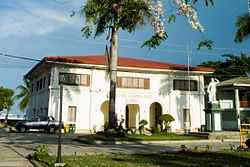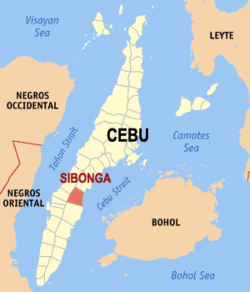Sibonga, Cebu
| Sibonga | |
|---|---|
| Municipality | |
 | |
 Map of Cebu with Sibonga highlighted | |
.svg.png) Sibonga Location within the Philippines | |
| Coordinates: 10°02′N 123°34′E / 10.03°N 123.57°ECoordinates: 10°02′N 123°34′E / 10.03°N 123.57°E | |
| Country | Philippines |
| Region | Central Visayas (Region VII) |
| Province | Cebu |
| District | 1st district of Cebu |
| Barangay | 25 (see § Barangays) |
| Government[1] | |
| • Type | Sangguniang Bayan |
| • Mayor | Lionel Bacaltos (NP) |
| • Vice mayor | Cirilo Apuda |
| • Town Council |
Members
|
| Area[2] | |
| • Total | 133.45 km2 (51.53 sq mi) |
| Population (2010)[3] | |
| • Total | 43,641 |
| • Density | 330/km2 (850/sq mi) |
| Time zone | PST (UTC+8) |
| ZIP code | 6020 |
| IDD : | +63 (0)32 |
| Income class | 3rd class |
| PSGC | 072246000 |
Sibonga is a third income class municipality in the province of Cebu, Philippines. According to the 2010 census, it has a population of 43,641.[3]
Sibonga has begun developing the town to become more industrial while still preserving its natural bounty. Sibonga is abundant in root crops, corn, rice, coconuts among others. The public market is held every Saturday in Poblacion.
Sibonga also now has Sibonga Community College which offers 4-year courses to its inhabitants.
The town fiesta is every August 10. This celebrates the birth of Santa Filomena. Sibonga has 2 patron saints – Santa Filomena and Nuestra Señora del Pilar.
Barangays
Sibonga comprises 25 barangays:[2]
- Abugon
- Bae
- Bagacay
- Bahay
- Banlot
- Basak
- Bato
- Cagay
- Can-aga
- Candaguit
- Cantolaroy
- Dugoan
- Guimbangco-an
- Lamacan
- Libo
- Lindogon
- Magcagong
- Manatad
- Mangyan
- Papan
- Poblacion
- Sabang
- Sayao
- Simala
- Tubod
Demographics
| Population census of Sibonga | ||
|---|---|---|
| Year | Pop. | ±% p.a. |
| 1990 | 33,083 | — |
| 1995 | 35,897 | +1.54% |
| 2000 | 38,281 | +1.39% |
| 2007 | 40,765 | +0.87% |
| 2010 | 43,641 | +2.51% |
| Source: National Statistics Office[3][4] | ||
See also
References
- ↑ "Municipalities". Quezon City, Philippines: Department of the Interior and Local Government. Retrieved 8 April 2013.
- ↑ 2.0 2.1 "Province: Cebu". PSGC Interactive. Makati City, Philippines: National Statistical Coordination Board. Retrieved 8 April 2013.
- ↑ 3.0 3.1 3.2 "Total Population by Province, City, Municipality and Barangay: as of May 1, 2010" (PDF). 2010 Census of Population and Housing. National Statistics Office. Retrieved 1 April 2013.
- ↑ "Population and Annual Growth Rates by Province, City and Municipality: Central Visayas: 1995, 2000 and 2007" (PDF). National Statistics Office. Archived from the original (PDF) on 24 June 2011.
External links
 |
Barili | Carcar |  | |
| Dumanjug | |
Cebu Strait | ||
| ||||
| | ||||
| Argao |
| ||||||||||||||||||